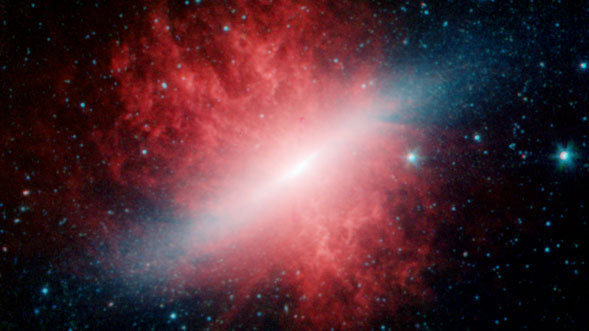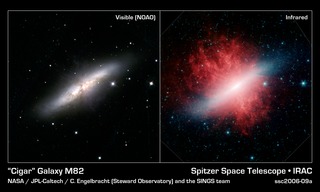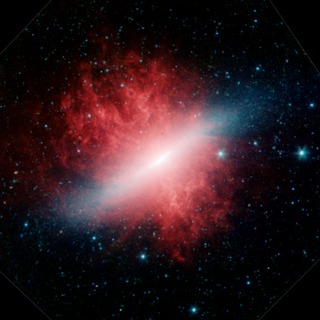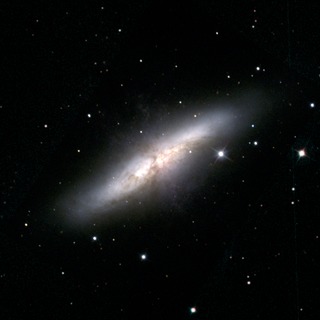
Credit: NOAO; Infrared: NASA/JPL-Caltech/C. Engelbracht (University of Arizona) and the SINGS Legacy Team
Observation • March 16th, 2005 • ssc2006-09a
ssc2006-09a
This image composite compares a visible-light view (left) of the "Cigar galaxy" to an infrared view from NASA's Spitzer Space Telescope of the same galaxy. While the visible image shows a serene galaxy looking cool as a cucumber, the infrared image reveals a smokin' hot "cigar."
The visible-light picture of the Cigar galaxy, also called Messier 82, shows only a bar of light against a dark patch of space. Longer exposures of the galaxy (not pictured here) have revealed cone-shaped clouds of hot gas above and below the galaxy's plane. It took Spitzer's three sensitive instruments to show that the galaxy is also surrounded by a huge, hidden halo of smoky dust (red in infrared image).
The infrared image above was taken by Spitzer's infrared array camera. The dust particles (red) are being blown out into space by the galaxy's hot stars (blue).
Spitzer's infrared spectrograph told astronomers that the dust contains a carbon-containing compound, called polycyclic aromatic hydrocarbon. This smelly molecule can be found on Earth in tailpipes, barbecue pits and other places where combustion reactions have occurred.
Messier 82 is located about 12 million light-years away in the Ursa Major constellation. It is viewed from its side, or edge on, so it appears as a thin cigar-shaped bar. The galaxy is termed a starburst because its core is a fiery hotbed of stellar birth. A larger nearby galaxy, called Messier 81, is gravitationally interacting with Messier 82, prodding it into producing the new stars.
The infrared picture was taken as a part of the Spitzer Infrared Nearby Galaxy Survey. Blue indicates infrared light of 3.6 microns, green corresponds to 4.5 microns, and red to 5.8 and 8.0 microns. The contribution from starlight (measured at 3.6 microns) has been subtracted from the 5.8- and 8-micron images to enhance the visibility of the dust features.
The visible-light picture is from the National Optical Astronomy Observatory, Tucson, Ariz.
About the Object
- Name
- Cigar Galaxy • Messier 82 • M82 • NGC 3034
- Type
- Galaxy > Activity > Starburst
- Distance
- 11,700,000 Light Years
- Redshift
- 0.000677
Color Mapping
| Band | Wavelength | Telescope |
| Infrared | 3.6 µm | Spitzer IRAC |
| Infrared | 4.5 µm | Spitzer IRAC |
| Infrared | 5.8 µm | Spitzer IRAC |
| Infrared | 8.0 µm | Spitzer IRAC |
Astrometrics
- Position (J2000)
- RA =9h 55m 52.0s
- Dec = 69° 40' 51.0"
- Field of View
- 12.6 x 12.6 arcminutes
- Orientation
- North is 57.3° left of vertical








